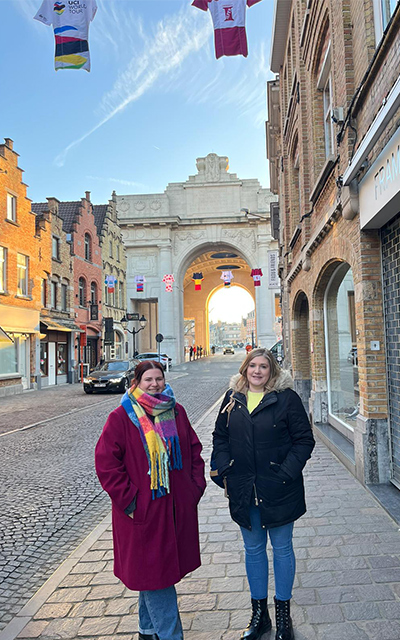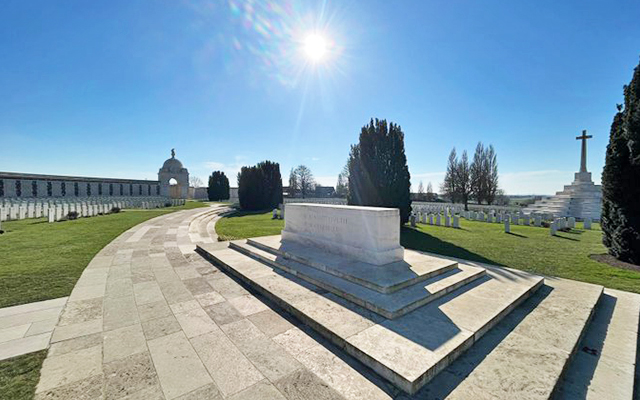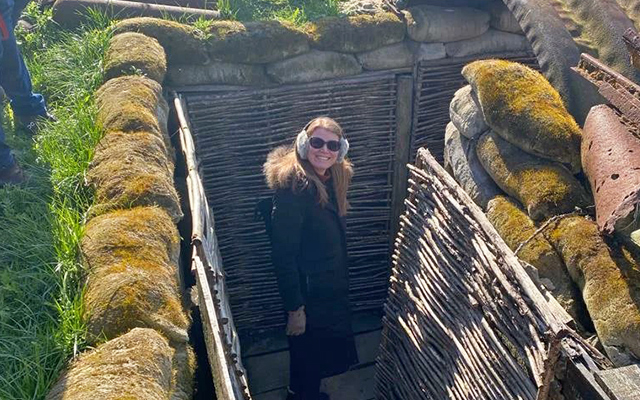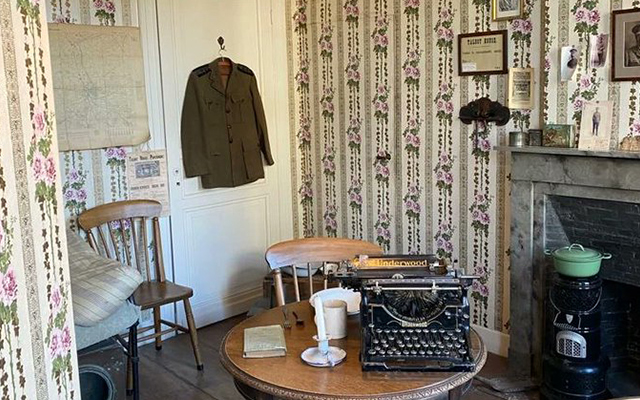Here, Zoe tells us what they discovered.
Laura, who has been to the WW1 battlefields many times, accompanied Megan and I to introduce us to some of our key suppliers and visits, so that we can continue to strengthen our working relationship with those suppliers and enhance our knowledge to ensure that we continue to be able to provide the highest customer service for our school groups travelling to the WW1 battlefields.
We enjoyed a wonderful three days in the WW1 battlefields of Belgium, in and around the Ypres area. This area was severely affected during WW1, as Belgium was a neutral country that held a strategic position between Germany and France.
Ypres makes the perfect base for a WW1 battlefields trip

We stayed right in the centre of Ypres, which was great. The town is really beautiful, and I was amazed that just over 100 years ago it was razed to the ground, only to be almost completely rebuilt after the war.
The Cloth Hall at the centre of the town is magnificent and houses the very important In Flanders Fields Museum, which many of our groups visit. The museum has had a recent update and offers three new educational programmes which link into the history curriculum.
The town is also home to the Menin Gate where the Last Post Ceremony is performed every evening at 8pm to commemorate and honour the many thousands of soldiers lost at war whose whereabouts remain unknown. Etched into the gate’s walls are the names of 54,000 such soldiers. Viewing the ceremony is a must when you visit the WW1 battlefields.
Many excellent educational visits in the area

We visited many of the cemeteries in the area. The one that I felt had the most impact on me was Tyne Cot.
The cemetery is really beautiful but also chilling when you see so many graves, line after line. The stones are all so bright in the sunlight and there really is a strong sense of peace there, which feels like such a contradiction when you think about how these cemeteries came to be.
A visit to Tyne Cot should also be tied into a visit to the Memorial Museum Passchendaele 1917. The museum is one of the largest in the area, with a small network of trenches that groups can experience. The museum is currently working on a new immersive room that will open in 2024.

I would also highly recommend a visit to the Hooge Crater Museum. This is a small museum which is privately owned. The owners’ passion for sharing their knowledge was second-to-none. They are also opening a new viewing platform in the former chapel to see across the former battlefields and cemetery across the way. The area can also be used for workshops.

Finally, you must visit Talbot House, the everyman’s club. Located in what was unoccupied Belgium, the club became a home away from home for many soldiers and allowed them some sanctuary. This is a truly lovely place to visit, offering a warm welcome to this day. It also shows how even in the worst situations, like war, humans manage to find some fun and laughter to keep them going. Run by volunteers, the house is so important to the community and their commitment shines through in the care they’ve taken of this historic building.
Great accommodation options
We visited a selection of the accommodation options on offer in the area, including the Menin Gate, Poppies 1 & 2, and the Salient. These are all sister properties with a very similar feel – all the multi-bedded bunk rooms have en-suite facilities. They also offer great communal spaces including games rooms and private teachers’ lounges.
We also visited the De Iep Hostel. Located just outside the town centre, this hostel is so welcoming, the staff are really great. The main bonus here is their outside space – they have a playing field out the back so groups can let off some steam after a day on the coach.
Lastly, we visited the Peace Village, situated in Messines. This is a village-style accommodation with studios, some of which are two levels with a living area great for the groups needing more space.
Why should you take your students to the WW1 battlefields?
A visit to the WW1 battlefields will really immerse students in the history of WW1 and the battles that took place in this area. The Belgian people will welcome you with open arms and are so keen to share the stories of this terrible war with you but also to show you how resilience shines through and how through conflict can come peace and resurrection.
A WW1 battlefields tour can be enjoyed in a 2-night stay but for more in-depth tours with more visits we recommend staying for three nights. You can even combine the tour to the Belgium battlefields with the Somme in Northern France by adding a third or fourth night.
We would like to thank Visit Flanders for hosting us on this wonderful trip along with P&O, Bibby’s and Galloway Coaches for their faultless driving and all the local suppliers who welcomed us during our trip.
Feeling inspired?
Please don’t hesitate to contact us for further information on our WW1 battlefields trips.